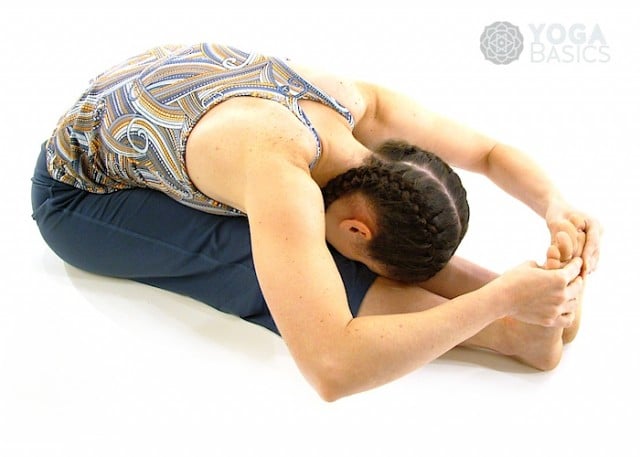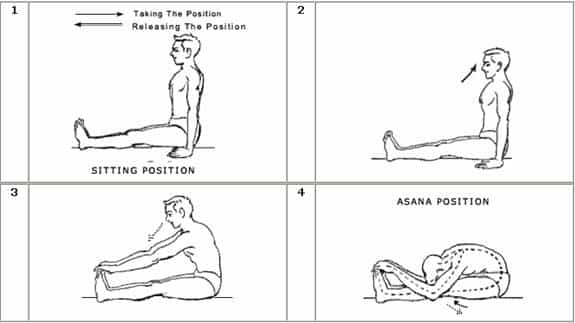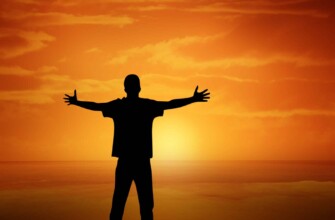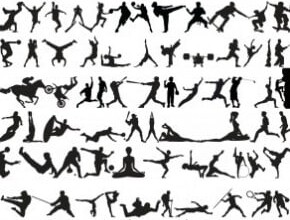 [adrotate group=”1″]This article describes in great detail how to do, step-by-step instructions, benefits, indications, contraindications, variations and accounts in ancient texts of seated forward bend also known as paschimottanasana.
[adrotate group=”1″]This article describes in great detail how to do, step-by-step instructions, benefits, indications, contraindications, variations and accounts in ancient texts of seated forward bend also known as paschimottanasana.
This posture can be a part of your everyday yoga practice. You can use it also in different sequences with other yogic postures. Pashcima means “west” or “back”, uttana is “intense stretching” and asana means “pose” in sanskrit . Thus, it means “pose of intense back stretching” that is how its name is formed.
- How to do paschimottanasana and step-by-step instructions for seated forward bend pose
- Benefits of paschimottanasana or seated forward bend
- Contraindications of paschimottanasana or seated forward bend
- Modifications and variations of paschimottanasana or seated forward bend
- Accounts in ancient texts of paschimottanasana or seated forward bend
- How to do asanas
How to do paschimottanasana and step-by-step instructions for seated forward bend pose
Here are step-by-step instructions on how to do back stretch pose (aka seated forward bend) or paschimottanasana. We all have different bodies. Therefore this is not a strict pattern and you may modify it according to your tastes and inner feelings.
The only criteria of the right pose is harmony when you do it and not a rigid set of rules or some picture of a yogi doing this asana. You can open your own posture in yoga. And enjoy it to its full extant. 
- Sit on the yoga mat with your legs in front of you. Put your palms beside your thighs. If you want you can make a couple of breaths. It doesn’t matter how much exactly.
- Lean a little bit forward from your thigh joints. Depending on your stretching capabilities you can add a little effort and grab your feet. If you can you can put your face upon your knees.
- If you feel comfortable you can grab different parts of your legs. You can interlock your fingers behind your feet. Also you can grab one wrist with the hand.
- If it is too difficult you can loop a strap around the soles of your feet. [adrotate group=”2″]
- Sometimes it is advised to keep your back straight and lengthen your front torso without arching it. You can experiment and find out yourself if it is pleasing to lengthen the back or it is ok to keep it a little arched.
- If your upper thighs lift off the floor you can apply a little effort and press them to the floor. Your knees may be bent just a little bit. There is no strict rule that your legs should be absolutely straight.
- Sometimes it is advised that the lower belly should touch the thighs first, then the upper belly, then the ribs, and the head last. If it is pleasing you feel that you want to do the asana this way you may do it.
- You may stay in that pose as long as you want. You may start with 1 minute for example. If it is harmonical and you don’t feel inner rejection you can extend the time in that pose.
- You can rock just a little backward and forward. You can do this a couple of times.
- After sometime, maybe seconds or minutes, you should gently release your seated forward bend. Lift up your head, then your upper belly, then your lower belly.
- After lifting your torso sit in the original position.
I will remind again that you may be an athlete with 10 years in professional sports behind you or you may be an elderly woman who got to know the word yoga yesterday. Of course, the intensity in this asana will differ for these two people.
It is not possible to describe paschimottanasana or any other posture for everyone. Harmony and no self-violence is what should guide you through a pose and not a strict instruction. If you cant do some point in the above-mentioned guide, that’s ok. It only a recommendation. Make your own pose. And this pose will fit you most.
Benefits of paschimottanasana or seated forward bend
[adrotate group=”3″]Benefits and positive effects of paschimottanasana may be different for different people. Every person has his/her uniquely designed body. And bow pose as well as any other yoga asana may give different results depending on the person who performs it. If you are a child it may give one thing, if you are an elderly person it may give something else. But here is short list of most likely results.
- It acts as a stress reliever.
- Reduces fatty deposits in the abdomen.
- Removes anxiety, anger and irritability.
- Calms the mind.
- Stretches the spine and improves our flexibility.
- Good for constipation and digestive disorders.
- Useful for increasing height.
- Regular practice cures impotency and enhances the sexual power.
- Tones the abdominal pelvic organs.
- Balance the menstrual cycles.
- This asana is recommended especially for women after delivery.
It’s quite possible that this pose will help you with something else that is not listed above. Also it might not help you with some disorders and you should practice it with other poses. As many people there are as many dhanurasans exist. So, it is not possible to list all benefits of this posture.
Therefore in different books and on different websites its positive effects differ a little. Sometimes the number of beneficial effects is less or more than I have written here. It depends on the person who does it. Because in different cases different people show different results.
Contraindications of paschimottanasana or seated forward bend
Depending on a person contraindications for bow pose as well as any other pose may vary a little. But one thing is sure, you should take paschimottanasana with great caution. Use common sense and don’t overstretch your body. If you have certain diseases it is strongly recommended that you consult a doctor. Asana is not a panacea or a cure-all. Don’t overestimate your capabilities.
Inner peace and harmony is also a guide worth following. The following list is just a thing worth taking into consideration and not a strict set of don’ts. If your inner feeling and intuition say that it is harmful to do this pose then you can do a simple variant. Or even you can do it in your mind. Be very careful and do a simple variant if you have the following diseases.
- Back injury including herniated discs
- Diarrhea
- Pregnancy
- Lumbosacral radiculities
- Chronicle arthritis
- High blood pressure or low blood pressure
- Breathing problems like asthma or emphysema
On different web sites precautions for this pose differ a little. For example, on one site there are only 1 precaution. The best way to know contraindications to a certain pose is to ask a doctor or a yoga-instructor who has a medical degree.
Even yogis damage themselves who do not follow the principles of inner harmony and common sense while doing a certain asana. If you have a disease mentioned above it doesn’t mean that you are forbidden to practice this pose. You may take a simplified version with the permission of a doctor. But anyway be careful. [adrotate group=”4″]
Modifications and variations of paschimottanasana or seated forward bend
If it is difficult to do seated forward bend you may use its different modifications and variations.
- You can sit in this pose inclining just a little.
- Depending on your capability of stretching you can come closer to your legs.
- You can hold breath while in the ending position. Or may breath normally.
- You can use a strap to loop it about your feet.
- You can bend your elbows and extend them sideways or you can press them closely to your legs.
- You may press out through your heels and gently draw the toes towards you. Or you may relax your feet a little. You should do it comfortably and pleasingly. No self-violence. No pain.
- You can bend the knees enough to reach the feet with the hands and to place the head on the knees.
- You can invent your own modification. There are no strict rules. Only an approximate pattern.
Accounts in ancient texts of paschimottanasana or seated forward bend
If you search for paschimottanasana in ancient texts or any other pose you will be surprised to find that their description is very short, laconic and terse. There are no ten-page-long descriptions of any pose. Here are just a few examples. परसार्य पादौ भुवि दण्ड–रूपौ दोर्भ्यां पदाग्र–दवितयं गॄहीत्वा | जानूपरिन्यस्त–ललाट–देशो वसेदिदं पश्छिमतानमाहुः || ३० || prasārya pādau bhuvi daṇḍa-rūpau dorbhyāṃ padāghra-dvitayaṃ ghṝhītvā | jānūparinyasta-lalāṭa-deśo vasedidaṃ paśchimatānamāhuḥ || 30 || “Having stretched the feet on the ground, like a stick, and having grasped the toes of both the feet with both the hands, when one sits with his forehead resting on the thighs, it is called Paschimottanasana”. (Hatha-yoga-pradipika 30).
इति पश्छिमतानमासनाग्र्यं पवनं पश्छिम–वाहिनं करोति | उदयं जठरानलस्य कुर्याद उदरे कार्श्यमरोगतां छ पुंसाम || ३१ || iti paśchimatānamāsanāghryaṃ pavanaṃ paśchima-vāhinaṃ karoti | udayaṃ jaṭharānalasya kuryād udare kārśyamaroghatāṃ cha puṃsām || 31 || “This paschimottanasana carries the air from the front to the back part of the body (i.e., to the sushumna). It kindles gastric fire, reduces obesity and cures all diseases of men.” (Hatha-yoga-pradipika 31.) prasārya pādau bhuvi daṇḍa-rūpau ! saṃnyasta-bhālaṃ citi-yugma-madhye ! yatnena pādau ca dhṛtau karābhyāṃ ! yoge1ndra-pīṭhaṃ paścima-tānam āhuḥ !!2.26! “Spread the two legs on the ground, stiff like a stick (the heels not touching), and place the forehead on the two knees, and catch with the hands the toes, This is called PaschimottAnAsana.” (Gheranda samhita 2.26)
“Pose for the stomach
This is a pose for the abdominal area. Lie down on the ground, breath in and put your arms above your head, then breathe out and bend forwards, grasp your ankles by hands. Make sure you legs and knees are straight. Remain in this position and let the energy flow inside you. Then touch your knees with your forehead. By doing this pose, you will get rid of any illnesses in your abdominal area, you will feel joy.” (Hatha yoga narrative 33)
How to do asanas
[adrotate group=”5″]If you want to do asanas and avoid injuries you have to follow very simple but important rules. First, you have to understand that every treatise gives us an approximate picture of an asana. It is not a strict code that everyone must obey. Or you might find a picture of a yogi twisted into three knots.
It doesn’t mean that he is doing that pose right and you do it wrong. Looking exactly like a guy in the picture or strict performance of an instruction in a book is not the criteria of the “right” asana. The Hatha-yoga narrative tells us what the right pose is.
Adya asked: What should I beware of, when studying hatha yoga, to avoid any mistakes during practice? The girlfriend replied: – Be careful of your laziness, avoid downward thoughts. The principles of yoga comprehension are the following. The first principle is the principle of perfection.
The second one is the principle of the energy. The principle of perfection is: no matter how you are doing yoga exercise, you are doing it perfectly well, even if it does not look exactly as it was prescribed to do. The fact of doing the exercise makes it perfect by itself, and you will get better each time when you are doing it. It is an intermediate perfection. In time you will reach unchanged final perfection.
That is why the expression «to do exercise incorrectly» is meaningless. The most important thing is to practice regularly and for a long time and be sure that in your own Universe at this moment of time and in these circumstances you do the asana perfectly. The principle of energy says that in the same way as a small ball in the funnel will always roll down the neck, when we do any asana the energy itself transforms the body.
There is no need to worry about doing it correctly. The main thing is to reproduce the pose, by doing it honestly, for a long time and regularly. Wake up the energy and the energy will do the yoga.
So, become an artist and create your own asana. Harmony and common sense will guide you. There should be no pain in an asana. That’s all for now.
Don’t forget to write in the commentaries below how to improve this article. What do you think is missing and what is unnecessary. Share it with friens if it was useful.








